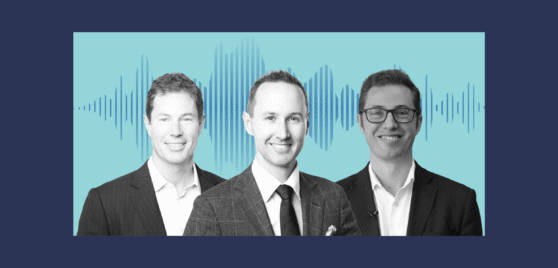Featuring Bruce Du
LISTEN
READ
Medibank is a long-term holding for IML. While it has performed well over the years, its share price has hit new heights this year as investors turned to defensive, domestically focused stocks amid the uncertainty and macro-economic volatility.
IML Equity Analyst Bruce Du talks Jason Guthrie through the investment case for Medibank, what has driven the recent share price appreciation, and whether he thinks Medibank has more in the tank.
Follow our podcast, ‘Navigating the Noise’ on Spotify, Apple or Amazon to be notified of new episodes.
 |
 |
 |
Lightly edited transcript – Recorded on 5 May 2025
Jason: Hello and welcome to Navigating the Noise, a podcast by Natixis Investment Managers, where we bring you insights from our global collective of experts to help you make better investment decisions. I’m Jason Guthrie, and today I am joined by Bruce Du, Equity Analyst in IML’s Large Cap team. We’ll discuss our stock of the month, Medibank Private, ASX ticker MPL.
Now, Bruce has been on the pod a few times now and always has fantastic insights. He’s very thoughtful with his commentary, very detailed, and I know his stocks always get a great following, so I hope you enjoy the conversation. Bruce, welcome back to the podcast. Great to have you.
Bruce: Great to be here, Jason.
Jason: So, Medibank, a name probably well known by our listeners. I guess it’s a bit of a necessary evil, health insurance. Maybe you can start by telling us why IML invests in Medibank and a couple of the more interesting things about the company.
Bruce: Sure. Thanks, Jason. So look, we are investors in Medibank. Firstly, they’re an industry leader with significant scale. They have attractive margins and strong operating cost efficiency, which means that they can reinvest in the business at a level that their competitors can’t match.
The second reason is really that private health insurance has a number of medium to long-term industry tailwinds, particularly a growing and aging population and a tax system in Australia that incentivises the uptake of private health insurance.
In terms of a couple of things that I think your audience may not know about the company, not only do they have an attractive private health insurance business, but they actually have another side of the business which aims to improve people’s health.
For example, they own one of the largest businesses that serve primary care, treating patients via GP visits before they go to hospital. Given that, it’s very synergistic with their private hospital business, because part of the way they make money is to ensure people don’t land in hospital in the first place.
Another thing which the audience may not know is they have a fantastic loyalty reward programme called Live Better. As a joiner of Medibank a couple of years ago, some of the real advantages in retention are if you look after your health—you know, you walk 10,000 steps a day and do the proactive things, which you can see on the app—they reward you by giving a couple of hundred dollars a year off your private health insurance premiums. You can also get free merchandise like Apple AirPods and all sorts of things, which I think helps to retain the customer. It’s a programme that none of their competitors really can match, and that goes to part of the reason why we think they’re just a better-quality business through that higher level of customer retention.
Jason: And can you maybe walk us through IML’s history in owning Medibank? I think it listed back in 2014, so just over 10 years ago. It was in the media a fair bit two or three years ago with the cyber attacks. Can you talk us through the trading history and how long you’ve held it?
Bruce: Yeah, sure. So we’ve probably held it, oh, just off the top of my head, probably four or five years, maybe a bit more than that. The cyber incident, which you referred to in 2022, was an opportunity where we quite significantly increased our position. We largely saw that as a one-off event for the company and took advantage of the share price decline, which had been quite substantial—just off the top of my head, 20-25% price declines.
At the end of the day, over the medium to long term, we viewed, going back to the point I made on scale, that Medibank, because of their size and profitability, could actually reinvest the most to enhance and fortify their cybersecurity, much more so than the competitors.
An interesting fact, if you look through the private health insurer statistics, whilst there are more than 30 health funds, the top sort of four or five really generate the majority of profits. The tail end of funds is actually a long list that aren’t profitable, and they don’t have the capacity to reinvest in things like cybersecurity.
So, again, we saw that as an opportunity for them to enhance their cyber defences. Because expectations around cybersecurity have lifted, the smaller funds, we think, have actually struggled to maintain the level of investment that the larger providers have been able to do.
Jason: It was obviously a pretty big event three years ago, stock price rerated, but was there much impact on the earnings and did they lose many customers through that period?
Bruce: Yeah, surprisingly, no. When you look at the overall churn statistics post the cyber event, there was a little bit around the edges, but relative to long-term churn, it’s actually been surprisingly steady. At the time, we did a number of channel checks with aggregators that also sell third-party private health insurance, and we took comfort that they weren’t seeing elevated levels of churn. That was actually one of the reasons why we added to our position the way we did. In terms of medium to long-term impacts on the business, as I said, it hasn’t really had a material impact.
Jason: So we’ve obviously had a bit of uncertainty in the market in the first quarter, the first four or five months of the year, and there’s been a lot of volatility. It has been more challenging for many Australian companies this year, but Medibank seems to have bucked that trend and had a really strong reporting season in February as well. Can you run us through the share price rally, the numbers, and does it have further to run?
Bruce: It’s always the $64 question. Yes, it has been a very strong performer, I think, off the back of a lot of the economic uncertainty around trade and tariffs. Medibank is a purely domestically exposed business. They’re not impacted by those external factors, so there’s obviously been a flight to safety.
Separate to that, though, I think the operating trends in the industry have been very positive, which has driven strong earnings growth. If you look at and contrast Medibank with its peers, we think that the management team focuses on a lot of the right things to drive long-term growth.
One of the key points of differentiation is their ability to retain customers. For example, you’ve got a lot of their competitors spending lots of money trying to acquire customers. While Medibank also does some of that, they have a much stronger focus on customer retention, which is, at the end of the day, the lowest cost way to keep customers. Those are the sorts of things we look at.
In terms of moving forward, the operating trends, as I mentioned, are quite supportive. The aging demographic, growing population, and the public health system is quite constrained in their ability to grow funding, so we continue to like the medium to long-term outlook for Medibank.
Jason: And does a business like that use a lot of gearing or do they have a lot of cash on the balance sheet?
Bruce: No. So actually for Medibank, they’re in a net cash position. A very strong balance sheet, when you look at the valuation I think they screen quite attractively, particularly when you’re looking at often comparing them to banks. No gearing, as I said, strong long-term tailwinds and very predictable. We can contrast how health insurers are different to general insurers later, but from our perspective, it ticks all the boxes.
Jason: I guess that flows through to dividends. Obviously, a big focus for IML is dividends, which often get forgotten in a strong market rally, but many of the higher dividend names on the ASX, like the banks and some of the resource companies, have been paying less over the last 12 or 18 months. How does the income look on Medibank shares?
Bruce: Yeah, look, so obviously with the strong share price appreciation, the yield isn’t as strong as it was 12 months ago. On our forecast, they’re still trading on a circa 4% fully franked yield, which we expect to grow. Bringing it back to a comparison with some of the banks, you look at CBA, I think they’re trading on a forward P/E of 25 or 26 times, a sub 3% dividend yield, and the earnings are not really growing—probably flattish at best—whereas Medibank has a more attractive yield, which we think can grow. So, from a relative valuation perspective and with no debt, it looks pretty solid.
Jason: And more broadly, you commented earlier that the insurance industry, in general, has been quite strong for the portfolios. Can you talk through some of those names quickly and why they’ve performed so well?
Bruce: Yeah, so I think if you look at the Australian insurance sector, one of the attractive attributes is the industry structure. We generally tend to have a few large players that dominate the sector. General insurers are a bit different from private health insurance in the way we think about it. Private health insurance, despite having over 30 different funds, the top two players have more than 50% of the market share. Whilst the health minister does have to approve annual pricing increases, the price increases are linked to their costs, so you get a pass-through.
In contrast to general insurers, you don’t have exposure to large external shocks, for example, severe weather events which might, in certain years, blow out your claims expense ratio. Health insurance is actually very predictable and has been over a long period of time. The premiums they collect are very steady, and their claims profile is steady and predictable. So you don’t get the volatility of earnings that you can see in general insurers.
Looking forward, again, we think the insurance industry will continue to remain attractive. Private health insurance, for the reasons I mentioned, and general insurers, notwithstanding the earnings volatility, do have the ability to reprice. While they can take hits in certain years, generally in the second, third and fourth year, they’ll take pricing to recover margins. So it really comes down to industry structure. In Australia, the insurers are generally in a very attractive industry structure.
Jason: Well, we might wrap it up there. Thank you, Bruce. Great to talk through a well-known and some would say iconic Australian brand and company. Thanks for everyone listening in today. We do hope you enjoyed IML’s Stock of the Month, Medibank Private.
Please click follow or the bell icon on your favourite podcast platform to hear more from Bruce and the IML team, as well as others from our global collective of experts.
Disclaimer:
This podcast has been prepared and distributed by Natixis Investment Managers Australia Proprietary Limited, ABN 60 088 786 289, AFSL 246830 and includes information provided by third parties, including Investors Mutual Limited (“IML”) AFSL 229988, the responsible entity and investment manager for the IML Funds.
Although Natixis Investment Managers Australia believes that the material in this podcast is correct, no warranty of accuracy, reliability, or completeness is given, including for information provided by third parties except for liability under statute which cannot be excluded. This material is not personal advice. The material is for general information only and does not take into account your personal objectives, financial situation or needs. You should consider and consult with your professional advisor whether the information is suitable for your circumstances. The opinions expressed in the materials are those are the speakers and may not necessarily be those of Natixis Investment Managers Australia or its affiliate investment managers. Before deciding to acquire or continue to hold an investment in a fund, you should consider the information contained in the product disclosure statement in conjunction with the target market determination, TMD, available at www.stg-imlimited-staging.kinsta.cloud.
Past investment performance is not a reliable indicator of future investment performance and no guarantee of performance, return of capital, or a particular rate of return is provided. Any mention of specific company names, securities or asset classes is strictly for informational purposes only and should not be taken as a recommendation to buy, hold, or sell. Any commentary about specific securities is within the context of the investment strategy for the given portfolio. The material may not be reproduced, distributed, or published in whole or in part without the prior written consent of Natixis Investment Managers Australia.
Copyright 2025 Natixis investment Managers Australia. All rights reserved.
INVESTMENT INSIGHTS & PERFORMANCE UPDATES
Subscribe to receive IML’s regular performance updates, invitations to webinars as well as regular insights from IML’s investment team, featured in the Natixis Investment Managers Expert Collective newsletter.
IML marketing in Australia is distributed by Natixis Investment Managers, a related entity. Your subscriber details are being collected by Natixis Investment Managers Australia, on behalf of IML. Please refer to our Privacy Policy. Natixis Investment Managers Australia Pty Limited (ABN 60 088 786 289) (AFSL No. 246830) is authorised to provide financial services to wholesale clients and to provide only general financial product advice to retail clients.






